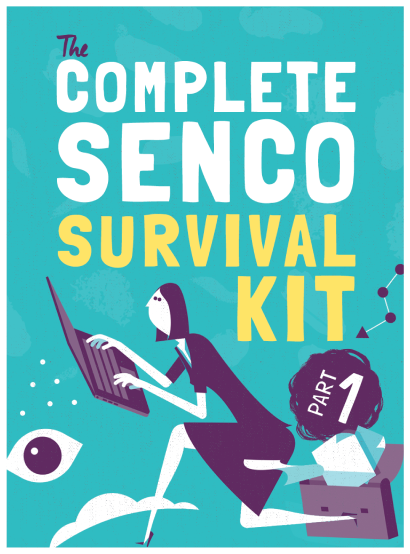SENCo – The role, its challenges and how to succeed

Being a SENCO means juggling many different roles while managing a challenging workload. Here we share advice about how to excel in this multifaceted role…

- by Teachwire
- Classroom expertise and free resources for teachers

It takes an all-rounder to be a good SENCO. You need to be a team player, an effective communicator, a leader, an advocate and most importantly, someone with understanding.
Managing the workload of a SENCO isn’t for the faint-hearted though. You’re often expected to be a leader, trainer, manager, bookkeeper, advocate and counsellor. This is all in addition to your teaching role, if you hold one.
Suffice to say, the SENCO role is a vast, diverse and morally compelling job. What follows is expert advice on what the role actually entails, and how to do it well…
What legal responsibilities does a SENCo have?
Solicitor Douglas Silas looks at what the role of a SENCo involves from a legal perspective…
The goal of every SENCo is to provide the best opportunities for pupils with special educational needs and disabilities. This means knowing about the legal dimensions of your school’s SEND provision.
What does a SENCo do?
The SENCo role in school involves:
- having an awareness of the law regarding disability discrimination or exclusions
- knowing the specifics of SEND funding
- understanding the processes involved with giving pupils statements of SEN and education, health and care plans (EHCPs)
- knowing how to transfer statements of SEN to EHCPs
- undertaking annual reviews
- knowing what you need to provide for the vast majority of pupils with SEND on your school’s SEN register who do not have a statement/EHC plan
- represent the school at various seminars, meetings and hearings
- work with parents, governors, educational psychologists, therapists and external agencies
- liaise with further education colleges, family support workers, youth groups and voluntary bodies
If that’s not enough, in addition, SENCos usually have teaching duties to fit in on a daily or weekly basis. Never mind 24/7 – the workload of the average SENCo is closer to 25/8!
The SENCO’s ‘bible’
The National Standards for Special Educational Needs Coordinators (1998), sets out four suggested areas of SEN coordination:
- Strategic direction/ development of SEN provision in school
- Teaching/learning
- Leading and managing staff
- Efficient/effective deployment of staff and resources
The key piece of SEN legislation that SENCos must be familiar with is Part 3 of the Children and Families Act 2014.
The SENCo’s ‘bible’, however, is the ‘SEND Code of Practice’ (‘CoP’), which elaborates on your legal requirements and provides guidance on education of children with SEND.
SEN register
A school will add a pupil to its SEN register if they believe the student requires additional support to ensure they are making good academic progress.
This is likely to occur when a pupil appears to have made little or no progress, after you have already tried different teaching styles, changing the learning environment, bringing in additional help or changing the curriculum.
SEND CoP
The SEND CoP recognises four different areas of need:
- communication and interaction
- cognition and learning
- social, emotional and mental health
- sensory and/or physical needs
SENCos work alongside teachers to find ways of supporting and improving pupils’ learning whilst they are receiving school-based SEN support. They ensure that each pupil’s progress is regularly monitored and reviewed.
If a pupil is not making adequate progress, you’ll need to look at providing additional support for the pupil via external specialists or agencies.
If that pupil has received SEN support with little or no success, it is a SENCo’s responsibility to see whether they should be formally assessed for an EHCP.
What do we mean by ‘inclusion’?
Importantly, a SENCo is ultimately responsible for inclusion of SEND pupils in a mainstream school. ‘Inclusion’ in this sense refers to including all pupils – both with and without SEND – in the educational opportunities and activities available.
It also promotes the principle of treating all pupils equally and fairly, whatever their educational needs may be.
SENCos also have to oversee and be involved in transition periods. In KS1 and KS2, this is more to do with helping to co-ordinate and plan educational opportunities for them.
However, when they move from KS3 to KS4, a SENCo must help pupils with SEND be aware of, and start to consider, their academic career options.
A SENCo has to work with the whole school to try and promote inclusion, which may be easier said than done!
The varying needs of pupils with SEND will greatly affect how successfully they can (or indeed want) to be included in a mainstream class.
Douglas Silas is the principal of Douglas Silas Solicitors.
What challenges do SENCos face?

Beth Cubberley, SENCo and deputy headteacher at Grove Wood Primary, explains…
The biggest challenge I face as a SENCo is the relentless paperwork. With almost 30 EHCPs in my school, I can mostly be found either chained to my desk drowning under said paperwork, or beneath it trying to avoid writing another One Plan!
I never thought all my training would lead me to this – it’s by far the biggest frustration, and one I can’t see changing unless the government decides to reassess its SEND agenda.
Struggling together
Despite working in a large school, there are sometimes days when I don’t actually see a child. However, there are many Facebook groups, inspirational people on Twitter and members of the DfE SENCo forum that make things more bearable by helping me realise we’re all struggling in the same way.
When things seem impossible, I have to remind myself that the children – the reason I became a SENCo – are far more important than filling in forms.
How to balance the SENCo workload
Michael Rogalski shares what he’s learnt on how not to blow a gasket…
Share the load
Learn the art of delegating. As a bit of a perfectionist in some ways, delegating is something that I will admit that I am still learning.
Teachers know the children in their class better than anybody so they are key people to look to support you in your role. Use their knowledge of the child to help you complete any paperwork and ask their opinion when it comes to review meetings.
A coaching approach to support staff in troubleshooting issues in the classroom is also worth considering.
Coaching can take different forms but the common outcome is to improve professional practice and make staff feel empowered to overcome any issues they have raised.
As a SENCO this can work well because initial support for pupils who have suspected SEN should include quality-first teaching and reasonable adjustments.
Simple, informal coaching conversations can lead to staff coming up with their own ideas of what adjustments they can implement to assist children in their class.
Be realistic
Think progress, not attainment. There is constant pressure to ensure children reach ‘Expected Standard’ but as we are all too aware, there are some children who, not matter how high our aspirations for them are, will find this too much of a challenge.
This is amplified further if they have SEN. I have unfortunately participated in training courses that tell teachers to pitch at the expected standard and beyond for most children.
In my view, we simply cannot do this in the vain hope that children will grasp it. If the foundations of learning are not present, this is highly unlikely to work.
Taking the progress approach ensures that children are building on their prior knowledge and are developing a solid base for future learning. Without a solid foundation, this becomes a significant issue for children as they move through education.
Correct tracking system
In my experience, the gaps in their knowledge hinder them from making additional progress. A child who is insecure with multiplication tables will no doubt find it extremely challenging to access some of the expected reasoning and problem-solving tasks when they reach Y6.
There is, of course, an argument that children need exposure to problem-solving and reasoning tasks, but if they are insecure with the fluency aspects of this area, this is where regular opportunities to practise, intervention and over-learning is required.
I try to overcome this issue with our children with more significant SEN by assessing them on a system that matches their needs.
Some children are able to demonstrate their progress on the whole-school tracking system, but some require objectives to be broken down into smaller steps.
Having children on the correct tracking system for them also ensures that their intervention or support plan targets are relevant and specific.
Community matters
Building relationships with parents is key. As class teachers will know, if parents are on board, things run more smoothly and this same as a SENCO.
Keep communicating with them, even if the news isn’t always good. Most parents do appreciate good communication and will learn to trust you.
Children with more severe SEN will have your involvement for many years, so you need to build trust to ensure a positive relationship throughout the time a child is with you.
Log out
Take social media with a pinch of salt. When I became a SENCO, I joined a couple of Facebook groups but very quickly removed them.
Most people have good intentions, but the variation in posts between heavy rants and the perfect SEN resources was quite mind-blowing.
This is where I decided I would do what works best for our school and search for support when needed. Instead, I attend ‘SEN Update’ meetings run by our local authority which provide up-to-date and relevant guidance about all things SEN.
I often make a list of a few questions I have beforehand so I can ask them at the meeting or discuss them with SENCOs who attend. Networking events like this are a far more reliable source of information and guidance that what can be found on online forums.
As with many things posted online, we don’t fully know the credibility of the person or motives behind what they are typing!
Manage your release time wisely
Working from home isn’t always an option in some schools – particularly for SENCOs – with the number of parent/professional meetings we deal with, but it can be a good option.
From experience, productive hours can be dramatically reduced by the time you’ve found somewhere quiet to work and you’ve dealt with the fifth “have you got a minute?” query of the morning!
Michael Rogalski is a Y5 teacher and SENCO in Staffordshire. He is also a director of the charity, Our Space (Staffs) Ltd, which provides social opportunities for children and adults with disabilities.
Working effectively with parents as a SENCo
When parents and schools are on the same page, children with SEND can soar, says Sylvia Edwards – so here’s how to get there…
For parents to engage effectively, they must understand what their child is aiming towards. Do the parents of children with SEND in your school know how the following interact through long, medium and short-term planning?
- Aspirational outcomes (for leaving school)
- Expectations (for each year or key stage)
- Targets (termly goals)
They may be aware of targets – but do they understand how these extend into longer-term, futuristic steps along their child’s school journey?
Parents should be at the centre of provision-mapping processes and policies. Ensuring they have the necessary knowledge can be time-consuming, certainly, but it will prove rewarding.
All staff members should recognise parents as the ultimate solution to under-achievement.
Aiming right
Schools are expected to ‘aim high’ for all children, including those with SEND. It’s important to put this concept in context, and identify aspirations that are just right to ensure individual success.
Aiming too high risks failure if a child cannot reach the goals. When targets must be repeated on IEPs parents feel disappointed, learners become demotivated and teachers feel frustrated.
So parents must understand how ‘aiming high’ is targeted towards their child’s personal potential, why class activities are differentiated and how setting realistic goals ensures that each step leads towards planned outcomes.
When targets match individual potential – and result in learning – schools, parents and pupils can celebrate together and feel success at every step of the way.
Fostering independence
Independence is key to measuring achievement. Skills and knowledge can only be measured by what learners do themselves, without adult prompting. Parents can benefit from training on how to:
- Support reading and comprehension – the difference between tricky words and phonics; how to support both; how to question their child’s understanding of texts.
- Support spelling – techniques for learning (look, say, cover, write, check); how to respond in encouraging ways.
- Help with writing – models of grammar and different text types; the handwriting system.
- Support motivation – praising strengths before offering sensitive feedback.
- Develop independence – never never helping unnecessarily.
True targets
All parents want their child to succeed – but it is not always easy is it to talk about success for children with severe levels of cognitive impairment.
Measuring individual achievement is difficult. Teachers and SENCos often have the difficult job of collaborating on outcomes in ways that enable parents to remain futuristically positive and hopeful.
Children with severe cognitive difficulties have often languished within low aspirations, but no longer. Achievement for All (2014) relies on the accurate assessment skills of teachers and SENCos to tease out each child’s personal best and communicate aspirational, yet realistic, expectations to parents within an atmosphere of mutual trust.
Honesty is the only basis on which home-school collaboration thrives. I remember talking to a parent who had just discovered that her child had dyslexia, having been constantly reassured that he was ‘doing okay’, and told not to worry about the poor levels of writing that she observed.
When the truth finally came, it hurt. And that parent’s offer of valuable support, over many years, had been wasted.
Personal touch
Achievement for children with SEND also rests on personalisation – towards which schools need to work with parents.
It is easy for institutions and external professionals to place individuals into boxes according to common diagnoses. Yet pupils with autism do not all have the same needs, nor do all young people with SEMH (Social, Emotional and Mental Health) difficulties respond to exactly the same strategies.
Indeed, I believe that there are far more differences than commonalities within any identified SEND group.
We might also reflect that a ‘whole child’ is the sum of both its school and home parts. Given that children with SEND are individuals first, only genuinely personalised approaches will enable them to achieve planned outcomes.
For this to work, parents must be givers as well as receivers of information. Two-way partnerships enable vital knowledge about children’s learning styles and characteristics to be shared, effectively and productively.
Home learning
How do parents feed personalised learning from home? From the learner’s perspective, a target of ‘personal best’ requires motivation, spurred on by sensitive guidance and encouragement.
Children who sense that their parents are on the same wavelength as their teachers benefit from that combined strength.
They get away with nothing, and there are no gaps to fall through. Knowing that their parents have been trained, not only in what to expect from home and school work, but also how best to achieve it in terms of learning styles and strategies, inspires learners to try harder – and achieve, even against the odds.
Finally, it’s worth exploring ways in which parents can become more involved in the life of the school more generally.
Whilst families at one end of the spectrum may need help to support their child with homework or to encourage independence, others might welcome opportunities to get on board in more extensive ways, such as at policy level or on committees.
In whatever form it takes, though, parent power is always worth harnessing, for the benefit of schools and learners alike.
Sylvia Edwards is author of The SENCO Survival Guide.
SENCo FAQs
What is a SENCo and what does SENCo stand for?
A SENCo, or Special Educational Needs Coordinator, is a teacher responsible for overseeing the support and education of students with special educational needs within a school.
How do I become a SENCo?
To become a SENCo, you typically need to be a qualified teacher, gain experience in working with special educational needs, and complete a National Professional Qualification (NPQ) for SENCOs if you’re in the UK.
How much do SENCos earn?
SENCo salaries vary based on experience, location and the specific school. However, in the UK, they typically range from £28,000 to £50,000 per year.










